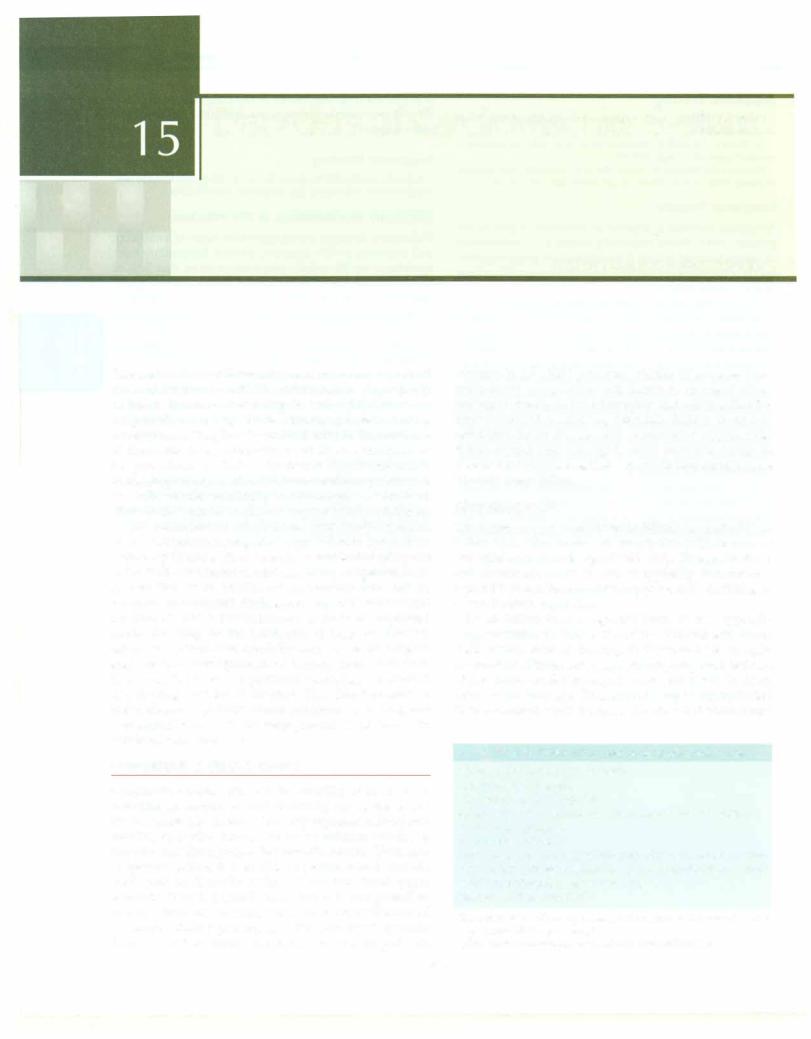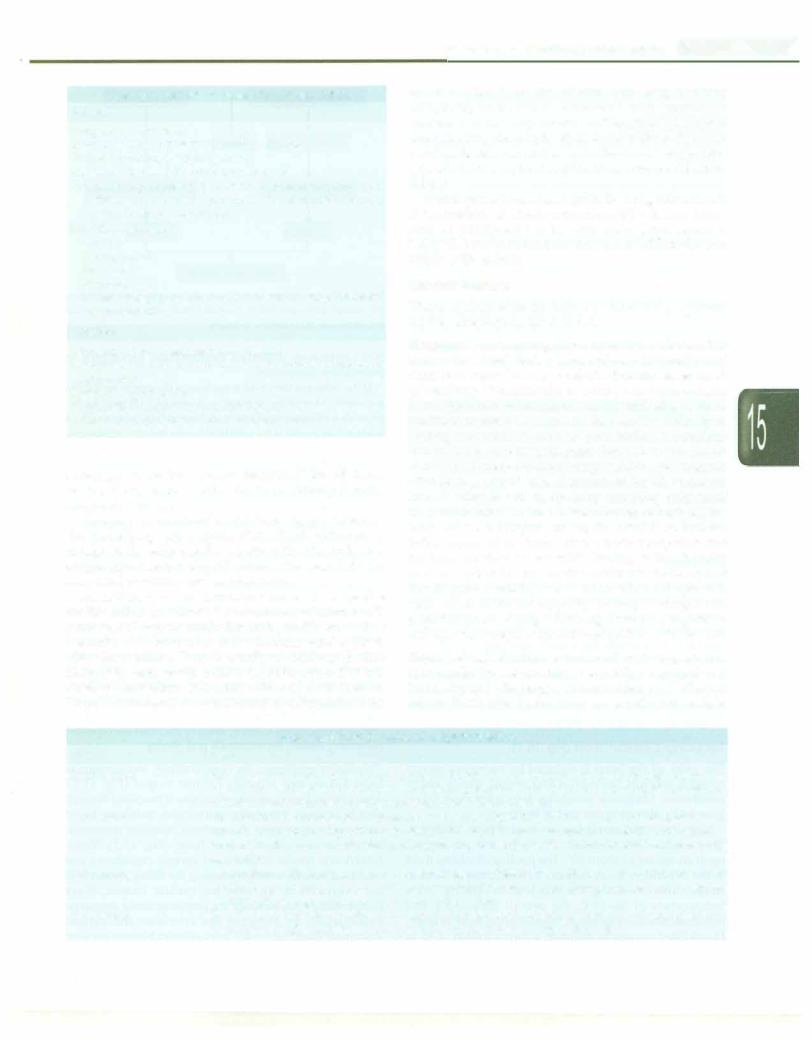
Ghai Essential Pediatrics8th
.pdf



|
|
|
Essen tiaiPed ia trics |
|
_______________________ |
||||||||||||||||||
|
__ |
_ |
_ |
_ _ |
_ |
_ _ |
_ |
_ |
_ _ _ |
_ _ |
_ __________ |
|
|
|
|
|
|
|
|
|
|||
|
J, Penph:r resistance J |
J, Venous return |
|||||||||||||||||||||
|
|
|
Poor weight gain |
|
|
|
|
|
|
|
|
||||||||||||
|
|
|
Table 15.4: Symptoms of cardiac failure |
|
|
|
|
|
|
|
|
|
|||||||||||
|
|
|
Difficulty in feeding |
|
|
|
|
|
|
i Cardiac |
outputj |
J, LVEDP---i |
1 |
||||||||||
|
|
|
Breathesshouldertoo fast; breathes better when held against the |
||||||||||||||||||||
|
|
|
Persistent cough and wheezing |
|
|
|
_! |
|
- |
|
i |
||||||||||||
|
|
|
Irritability, excessive perspiration and restlessness |
Improved tissue 02 |
J, Pulmonary congestion |
||||||||||||||||||
|
|
|
Pedal edema |
|
|
|
|
|
|
|
|
|
|
l |
|
|
|
-l |
|||||
|
|
|
Right-sidedfailure is indicatedbyhepatomegalyandfacial |
|
l Fatigue, |
|
|
l DyspneaJ |
|||||||||||||||
|
|
|
puffiness. Examination of the neck veins in small babies |
|
|
|
|
|
|
|
|
|
|||||||||||
|
|
|
|
|
|
|
Better work capacity |
|
|
||||||||||||||
|
|
|
is not helpful. Firstly, it is difficult to evaluate the short |
|
|
|
|
|
|
||||||||||||||
|
|
|
neck with baby fat and secondly, hemodynamic studies |
Fig. 15.1: By reducing the systemicvascularresistance and decreasing |
|||||||||||||||||||
|
|
|
show thatrightatrial mean pressures stays normal in more |
the venous tone vasodilators provide better work capacity. LVEDP |
|||||||||||||||||||
|
|
|
than one-half of infants with congestive failure. Edema |
left ventricular end-diastolic pressure |
|
|
|||||||||||||||||
|
|
|
on thefeetoccurslate. Common to bothleft and right sided |
|
|
|
|
|
|
|
|
|
|||||||||||
|
|
|
failure is the presence of cardiac enlargement, third sound |
50%, improves impaired oxygenation secondary to |
|||||||||||||||||||
|
|
|
gallop and poor peripheral pulses with or without |
||||||||||||||||||||
|
|
|
cyanosis (Table 15.5). |
|
|
|
|
|
pulmonary congestion. |
|
|
|
|||||||||||
|
|
|
|
|
|
|
|
If the infant or thechild isrestless or dyspneic, sedatives |
|||||||||||||||
|
l |
|
Table 15.5: Signs of congestive cardiac failure |
are used. Morphine sulfate in doses of 0.05 mg/kg SC |
|||||||||||||||||||
|
10 |
Left-sided |
|
Failure of either side |
Right-sided failure |
provides effective sedation. A benzodiazepine such as |
|||||||||||||||||
|
failure |
|
Cardiac enlargement |
Hepatomegaly |
midazolamisusefulforsedationinselectedcircumstances. |
||||||||||||||||||
|
|
Tachypnea |
|
Sedatives reduce anxiety and lower the catecholamine |
|||||||||||||||||||
|
|
|
Tachycardia |
Gallop rhythm (S3) |
Facial edema |
secretion, thusreducing physical activity, respiratory and |
|||||||||||||||||
|
|
|
Cough |
|
Peripheral cyanosis |
Jugular venous |
heart rate. Requirement of oxygen for body tissues goes |
||||||||||||||||
|
|
|
Wheezing |
|
Small volume pulse |
engorgement |
down, and this reduces the cardiac workload. |
||||||||||||||||
|
|
|
Rales in chest |
Lack of weight gain |
Pedal edema |
Fever, anemia or infection also increase the work of the |
|||||||||||||||||
|
|
|
heart. In infants and smaller children the presence of |
||||||||||||||||||||
|
|
|
|
|
|
|
|
|
|
|
|
|
|
|
superadded pulmonary infection is difficult to recognize. |
||||||||
|
|
|
Treatment |
|
|
|
|
|
|
|
|
|
|
Antibiotics are therefore, sometimes administered |
|||||||||
|
|
|
Management of heart failure is a four-pronged approach |
empirically. In older children antibiotics are used, only if |
|||||||||||||||||||
|
|
|
evidence of infection is present. |
|
|
||||||||||||||||||
|
|
|
for correction of inadequate cardiac output. The four |
Anemia |
imposes stress on the heart because of the |
||||||||||||||||||
|
|
|
prongs are: (i) reducing cardiac work, (ii) augmenting |
|
|||||||||||||||||||
|
|
|
myocardial contractility, (iii) improving cardiac perfor |
decreased oxygen carrying capacity of blood. Anemia |
|||||||||||||||||||
|
|
|
mance, (iv) correcting the underlying cause. Identification |
results in tachycardia and in a hyperkinetic circulatory |
|||||||||||||||||||
|
|
|
of the cause is important since it has dir ct bearing on survival. |
state.Correctionofanemiawill result indecreasedcardiac |
|||||||||||||||||||
|
|
|
If a newborn has heart failure due to duct dependent |
work. If transfusion is indicated packed red cells can be |
|||||||||||||||||||
|
|
|
administered. Typicallypacked cell volumes of 10-20 ml/ |
||||||||||||||||||||
|
|
|
systemic circulation (critical coarctation, aortic stenosis, |
kg are required to correct severe anemia; a single dose of |
|||||||||||||||||||
|
|
|
interrupted aortic arch), administration of prostaglandin |
frusemide IV is often given prior to the transfusion. Less |
|||||||||||||||||||
|
|
|
to open the closing duct improves survival. |
commonconditionscausingstress tothe heart arerepeated |
|||||||||||||||||||
|
|
|
Reducing Cardiac Work |
(Fig. 15. l) |
|
pulmonary emboli, thyrotoxicosis |
and obesity. |
||||||||||||||||
|
|
|
The work of the heart is reduced by restricting patient |
Vasodilators counteract the compensatory mechanisms in |
|||||||||||||||||||
|
|
|
activities, sedatives, treatment of fever, anemia, obesity, and by |
heart failure and improve cardiac output (Fig. 15.1). |
|||||||||||||||||||
|
|
|
vasodilators. Mechanical ventilation helps when heart failure |
Arteriolarandvenousvasoconstriction is mediatedthrough |
|||||||||||||||||||
|
|
|
is severe by eliminating the work of breathing. |
catecholamines. Arteriolar constriction maintains blood |
|||||||||||||||||||
|
|
|
Neonates with heart failure are nursed in an incubator. |
pressure by increasing the systemic vascular resistance, |
|||||||||||||||||||
|
|
|
They are handled minimally° . The baby is kept propped |
which increases the work of heart (Fig. 15.2). Veno |
|||||||||||||||||||
|
|
|
up at an incline of about 30 . The pooling of edema fluid |
constriction results in decreased venous capacitance and |
|||||||||||||||||||
|
|
|
in the dependent areas reduces the collection of fluid in |
increased venous return, increasing thefillingpressures of |
|||||||||||||||||||
|
|
|
lungs, thus reducing° the work of breathing. At a |
the ventricles to increase the cardiac output. Since |
|||||||||||||||||||
|
|
|
temperature of 36-37 C, the overall circulatory and |
compensatory mechanisms are inappropriately excessive, |
|||||||||||||||||||
|
|
|
metabolic needsare minimal, thus reducing work of heart. |
vasodilators, by reducing the arteriolar and venous |
|||||||||||||||||||
|
|
|
Humidified oxygen to maintain a concentration of 40 to |
vasoconstriction, reducetheworkofheart.Nitratesareused |
|||||||||||||||||||






